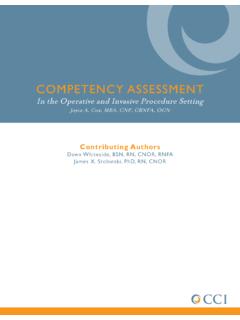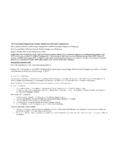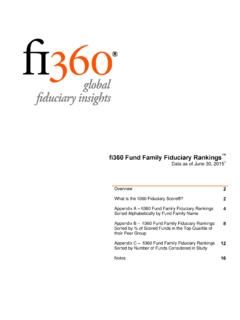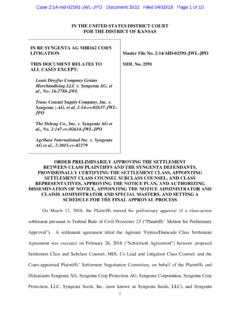Transcription of COMPETENCY ASSESSMENT - OR Today
1 COMPETENCY ASSESSMENTIn the Operative and Invasive Procedure SettingJoyce A. Cox, MBA, CNP, CRNFA, OCNC ontributing AuthorsDawn Whiteside, BSN, RN, CNOR, RNFAJ ames X. Stobinski, PhD, RN, CNORC ompetency ASSESSMENT in the Operative and Invasive Procedure Setting1 Operative and invasive procedures requiring the use of sterile technique are no longer performed only in the operating room (OR). Advances in technology and techniques have facilitated the performance of procedures in non-traditional settings beyond the OR. These include settings such as cardiac catheterization labs, physician offices, gastrointestinal labs and interventional radiology suites. This white paper provides definitions germane to the field and also addresses COMPETENCY ASSESSMENT for members of the nursing team and those supporting the delivery of care in the operative and invasive procedure safety and positive outcomes are the number one priority in operative and invasive procedure settings as the expectations of healthcare consumers and other stakeholders continue to rise in regard to nursing care.
2 This complex environment must meet regulatory requirements from agencies such as the Occupational Safety and Health Administration (OSHA)1, Centers for Medicare and Medicaid Services (CMS)2, The Joint Commission (TJC)3, Agency for Healthcare Research and Quality (AHRQ)4, licensure boards, certification boards and other federal and state regulatory the last 15 years, the methods of measuring and assessing COMPETENCY have markedly improved, offering tools that truly measure an individual s performance in a specific situation. COMPETENCY ASSESSMENT is one of the tools healthcare facilities can use to build a culture of quality patient care and potentially reduce the number of adverse outcomes. Within the operative and invasive procedure setting, it is one means of determining if nurses, surgical technologists and other staff members, including physicians and anesthesia professionals, are proficient and can demonstrate the technical, critical thinking and interpersonal skills necessary to provide safe patient care relevant to their specific role function.
3 COMPETENCY ASSESSMENT may be viewed as a professional responsibility and a commitment to our patients to practice in a safe manner. Engaging in ongoing professional development, of which COMPETENCY ASSESSMENT is but one part, fulfills an obligation to the patient to provide high quality care. COMPETENCY ASSESSMENT is a methodology to provide a higher level of assurance to our patients regarding our proficiency. Ideally, nurses and other healthcare professionals would each have a meaningful professional development plan to include periodic COMPETENCY ASSESSMENT and lifelong learning. In the absence of such plans, the employer assumes some responsibility and liability for the level of COMPETENCY of those working at the facility. Thus, COMPETENCY ASSESSMENT becomes part of workplace ASSESSMENT is not simply a list of tasks that are observed and checked off at a specified period of time.
4 Previously, healthcare facility managers used checklists of tasks annually to document COMPETENCY . While skills checklists may be part of the larger scheme of COMPETENCY ASSESSMENT , these lists may no longer serve as the sole source of measuring COMPETENCY . The days of using checklists as the INTRODUCTION COMPETENCY ASSESSMENT in the Operative and Invasive Procedure Setting2only measurement of COMPETENCY are long gone, and facilities still using a single method such as an annual skills ASSESSMENT do not truly evaluate COMPETENCY . Donna Wright, BS, MSN, RN, a well-known author in the COMPETENCY field, states:This paper provides definitions of the various terms used in the field of COMPETENCY ASSESSMENT and addresses COMPETENCY ASSESSMENT for members of the nursing team as well as those supporting the delivery of surgical care in the operative and invasive procedure suite.
5 The results of Montogmery s Perioperative Nurse COMPETENCY Continuum Study,6 carried out in conjunction with a job analysis for perioperative nursing, reinforced current thinking on this subject. A job analysis is integral to the certification examination process and produces task and knowledge statements that delineate the role being studied. These task and knowledge statements may also fill another purpose in that they can be used in the COMPETENCY ASSESSMENT process. Inconsistent methods of defining and measuring clinical COMPETENCY create the biggest obstacle in measuring COMPETENCY ASSESSMENT . Levine and Johnson state there is no common definition of competence and no evidence for one best method to assess competence 7( ) Secondary to the issues regarding definitions of COMPETENCY , many healthcare facilities focus on measuring the individual s ability to perform a given skill, not on their ability to perform in a practice setting.
6 When applied to perioperative nursing, this approach reinforces the misconception that perioperative nursing is but a collection of tasks. This detracts from the complexity of perioperative nursing and denigrates the critical thinking skills so crucial in the profession. The definitions and methods described in this educational offering may assist perioperative managers striving to assess COMPETENCY and move beyond the simplistic notion of annual skills fairs. With the goal of assessing COMPETENCY in mind, establishing definitions of relevant terms is a priority. A collection of those terms follows. COMPETENCY ASSESSMENT is only meaningful when it reflects the dynamic nature of the job. This means you will not have one list of competencies or skills identified for a job that you will simply check off over and over each year; instead your competencies will be a collection of skills, abilities, and behaviors that address the changing nature of the job for a given period of (p 2)DEFINITIONS COMPETENCY ASSESSMENT in the Operative and Invasive Procedure Setting3 Competence refers to a potential ability and/or a capability to function in a given While the terms competence and COMPETENCY are often used interchangeably, there is a distinct difference.
7 Competence is the capacity to perform specific to a role and includes other behavioral attributes that make someone successful in that Before COMPETENCY can be assessed, it must first be defined. The following definitions capture the essence of COMPETENCY . COMPETENCY , as described by Stobinski,10 is what a nurse is capable of doing and is manifested in measurable actions and behaviors. It is one determinant of performance, but the relationship between competence and COMPETENCY is not direct, and the exact contribution an individual s capability to the larger picture of performance is unknown. Wright5(p 8) defines COMPETENCY as the application of knowledge, skills and behaviors that are needed to fulfill organizational, departmental and work-setting requirements under various real world circumstances. Schroeter makes a defining statement in this field, stating, COMPETENCY focuses on one s actual performance in a situation.
8 This means competence is required before one can achieve COMPETENCY . 8( ) Specific to the OR, AORN defines COMPETENCY as the knowledge, skills, and abilities needed to fulfill the professional role of an RN in the ,12 Continued competence, as defined by the Hospice and Palliative Credentialing Center (HPCC) is the on-going commitment of a registered nurse to integrate and apply the knowledge, skills and judgment with the attitudes, values and beliefs required to practice safely, effectively and ethically in a designated role and setting. 13 The concept of continued competence has recently come to the forefront as a means to demonstrate ongoing learning, professional development and to protect patients. Lateef states that one salient reason to address the issue of measuring COMPETENCY is to keep pace with the accelerated evolution of technology and increased consumer The credentialing industry, of which certification programs such as the CNOR certification is but one part, has become a discipline with a more structured, principle-based approach to continuing competence and credentialing.
9 From that standpoint of a principle-based approach, we can consider Knapp & List s14 2009 definition of continuing competence as the ability to perform a role at specified levels of knowledge and skill not only at the time of initial certification but also throughout an individual s professional describes COMPETENCY ASSESSMENT as a dynamic ongoing process where skills are obtained in three distinct phases: when hired, during initial practice and on-going practice. The competencies are different at each level of practice and correspond to phases where skills are obtained. This clearly has parallels to the work of Benner who described a novice to expert ,16 Stobinski10 discusses the relationship of performance to COMPETENCY ASSESSMENT and how this can be used to identify areas of professional development and educational Competence COMPETENCY Continued Competence COMPETENCY ASSESSMENT COMPETENCY ASSESSMENT in the Operative and Invasive Procedure Setting4needs.
10 This allows managers to align competencies with patient care needs. Thus, COMPETENCY ASSESSMENT , in a well-designed program, can be seen as a key element in a professional development program designed to continually elevate knowledge and skill levels. In one commonly used framework (the KSA model), the three components of COMPETENCY are described as knowledge, skills and This KSA framework provides a helpful perspective through which the process of COMPETENCY ASSESSMENT may be viewed. For example, knowledge acquired through formalized education and training is usually gained in a didactic mode. This classroom experience provides a significant contribution to knowledge levels. In the perioperative setting, employee roles are diverse; however, there are three primary groups of non-physician providers that comprise the majority of personnel in the OR: Registered nurses (RNs), surgical technologists (STs) and central processing technicians (CPTs).




